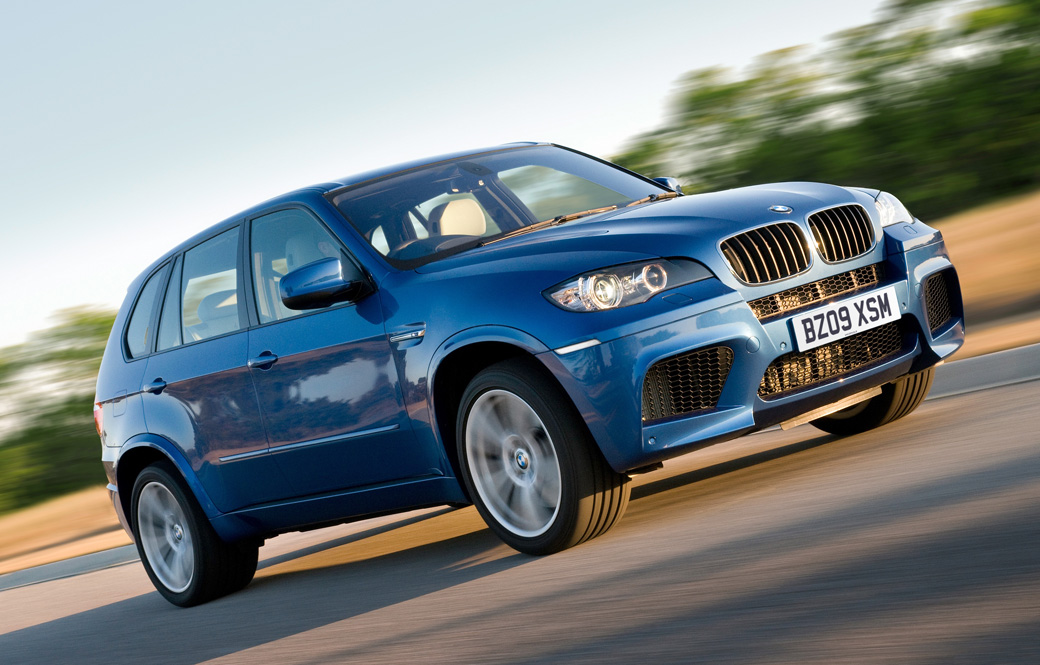The Clarkson review: BMW X5M (2010)
As we know, the car industry is guaranteed to be out of step with any financial conditions that happen to be prevailing at the time. The world is always awash with supercars when stockbrokers are hurling themselves out of windows, and riddled with eco-boxes when people are spending more than the cost of a Kia on a pair of shoes.
There’s a good reason for this. You start to design a car at least four years before it reaches the showroom. And in four years, a lot invariably happens. There is now, for instance, a mad scramble to produce hybrids and cars that have to be charged up at night. And I can guarantee — absolutely guarantee — that when they all reach the streets, someone will either have proved conclusively that such cars are bad for the environment or that the planet’s finances have improved to such a point that no one is even remotely interested in 55mpg.
Search for and buy a BMW X5 M on driving.co.uk
It was always thus. The Jaguar XJ220 was conceived in a time of plenty and then crept onto the market in 1992 — just before Black Wednesday rendered the concept of a 220mph supercar ludicrous. So then Jaguar went off to work on a slightly wooden version of the Ford Mondeo that would do well in the lean times. And that entered the marketplace when the front porch on a terraced house in Mansfield was worth half a billion.
Needless to say, Jaguar is now putting the finishing touches to the swish new bankers’ special, the XJ. And I’m sure they’ll all welcome it as a soft ’n’ comfy landing pad when they hurl themselves from the top of Canary Wharf.
Mercedes, of course, being German and therefore very organised, does not allow itself to get into this situation. It makes a car for absolutely everybody in ze world at all times. It doesn’t matter whether you are a Vietnamese pig farmer or Bernard Madoff, there is always a Mercedes to suit. There is the A-class, the B-class, the C-class, the D for diesels, the E-class and so on, all the way through to S when the nomenclature goes berserk. There is the S, the SL, the SLK and the SLS.
You want an off-road Mercedes? Well, you can have a GL-class, an M-class, or an R-class, all of which are big, boxy and pulled along by all four wheels. Volkswagen, too, ensures that it has all the bases covered. You want a Golf, you buy a Golf. You want a Golf for less money, you buy a Skoda. You want a Golf but you are Spanish, you buy a Seat. You want a Golf but you play football in the Champions League: you buy an Audi. Same car. Different circumstance.
BMW has now adopted a similar policy with a vast new range of cars, some of which are excellent and some of which, like the 5-series GT, seem to have no point at all. It is a slightly raised 7-series, billed as something less good, and fitted with a hatchback. The economic conditions in which such a thing might be desirable are hard to imagine. Especially as it looks like an Austin Maxi. The X6, a massive off-road car with a coupé-style body is even more bonkers, and then there is the subject of this morning’s missive — the X5 M.
The old, original X5 was quite interesting from a technical standpoint. Because what BMW attempted to do was marry the concept of an SUV with the sporting, superfast DNA that has coursed through the company’s bloodline since the Fw 190. The result was a car that had a high driving position and a bit of deftness in the bends. But then along came the new version and everything went a bit wrong.
The deftness had gone. It was woolly. So we all saw it for what it was. A rather ugly, rather ungainly SUV that came with five seats and a big boot — the same as a Ford Focus — or seven seats and a boot so small that the RSPCA would come knocking if you put a hamster in there.
To address these things, BMW’s Motorsport division has been busy creating the first ever M-powered X5. We must take this seriously because BMW’s M cars are almost always a cut above. The M5 is biblically good and the current M3, divine. It’s a full five seconds faster round the Ascari track than Merc’s 6.2-litre C-class and Audi’s RS4.
The X5 M pulls off a similar trick. There is simply no other big SUV that goes, steers, stops or turns even half as well as this. You can fling it into bends and while the traction control is already ready to step in and stop you having too much fun and games, you can get the back to step out of line and sit there, in a controlled slide, just like you can with an M5 saloon.
Actually, I’m being silly. It’s nothing like an M5. An M5 is 5,000 times better in the bends because it’s lower and therefore has the laws of physics on its side. The X5 M is good for an SUV, and that’s it. The engine is particularly notable as this is the same unit that will be fitted to the next M5 — due to go on sale in 2011. It’s a 4.4-litre twin-turbocharged V8 so you get lots of power, tons of torque and fewer carbon dioxides than you did from the back of the V10. The best thing, though, is the complete absence of turbo lag.
When turbos first came onto the scene — in a BMW incidentally, unless you are an American, in which case you will claim it was on a Chevrolet — there was always a pause from the moment you put your foot down to the moment anything happened. Sometimes, in the case of Saab’s turbo, the pause was about a year, and we accepted this because it was bound to take time for the exhaust gases to spool up the fan that would drive another fan forcing more air into the engine. Well, in modern turbocharged engines, the pause is all but gone. In the BMW, it has gone completely.
There are, of course, a few downsides to its new-found sharpness. Like it’s fitted with fat tyres that render the car utterly useless in a field and are fairly hopeless everywhere else too. On a bumpy B road, the ride is so firm, you find yourself hanging on to the steering wheel just to stop yourself being bounced out of the seat. It’s not good enough, this. Not by a long way.
Nor is the interior, which is just about all right on a £40,000 diesel. But is emphatically not all right on a £78,000 heavyweight ballet dancer. And then there are the problems that blight its lesser brothers and sisters. Chief among these problems is the iDrive system, which offers up a wide range of driver options, none of which makes any sense. I did quite like the head-up display, though. Because when you are that high above the road, you really do feel like you’re in a low-flying jet.
That said, I don’t really think the X5 M makes much sense except on a track, where it doesn’t make half as much sense as the cheaper, better M5, which, incidentally, comes with just as many seats. Like the original, it’s clever from a technical standpoint but times have to be good for a car like this to make sense. And they aren’t. So it doesn’t.
If you need a tall off-road car, buy a Range Rover diesel. If you need a five-seater that is fun, buy an M5. Don’t try to buy something that combines both things because what the X5 M proves is that really, it can’t be done.
Search for and buy a BMW X5 M on driving.co.uk






